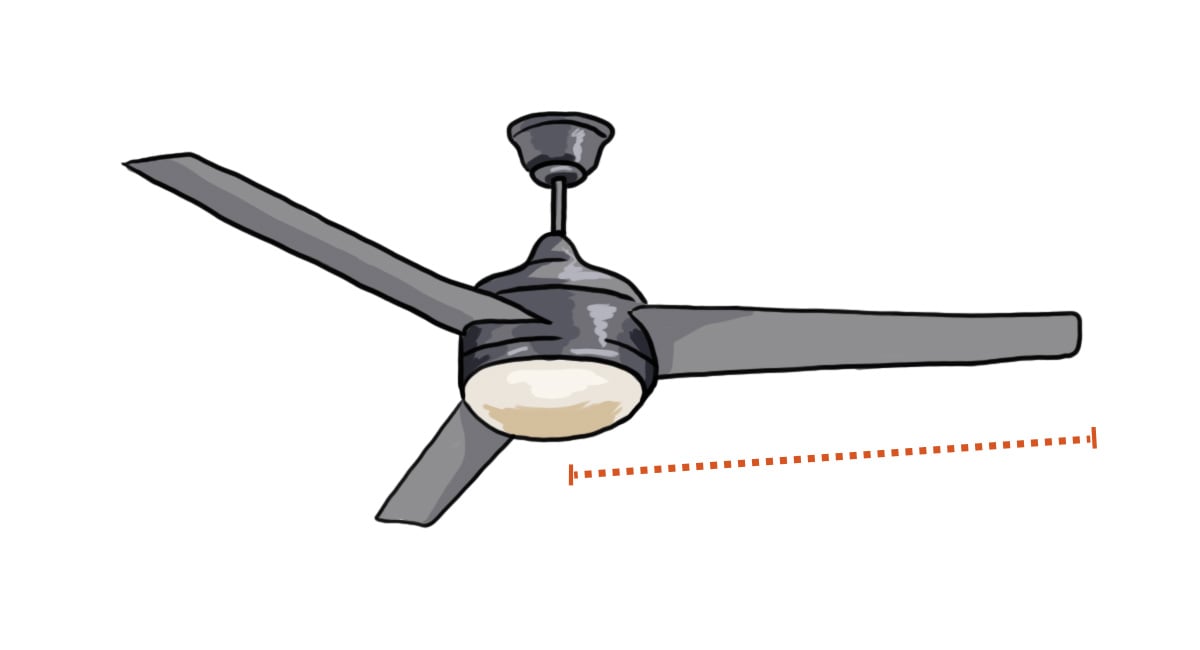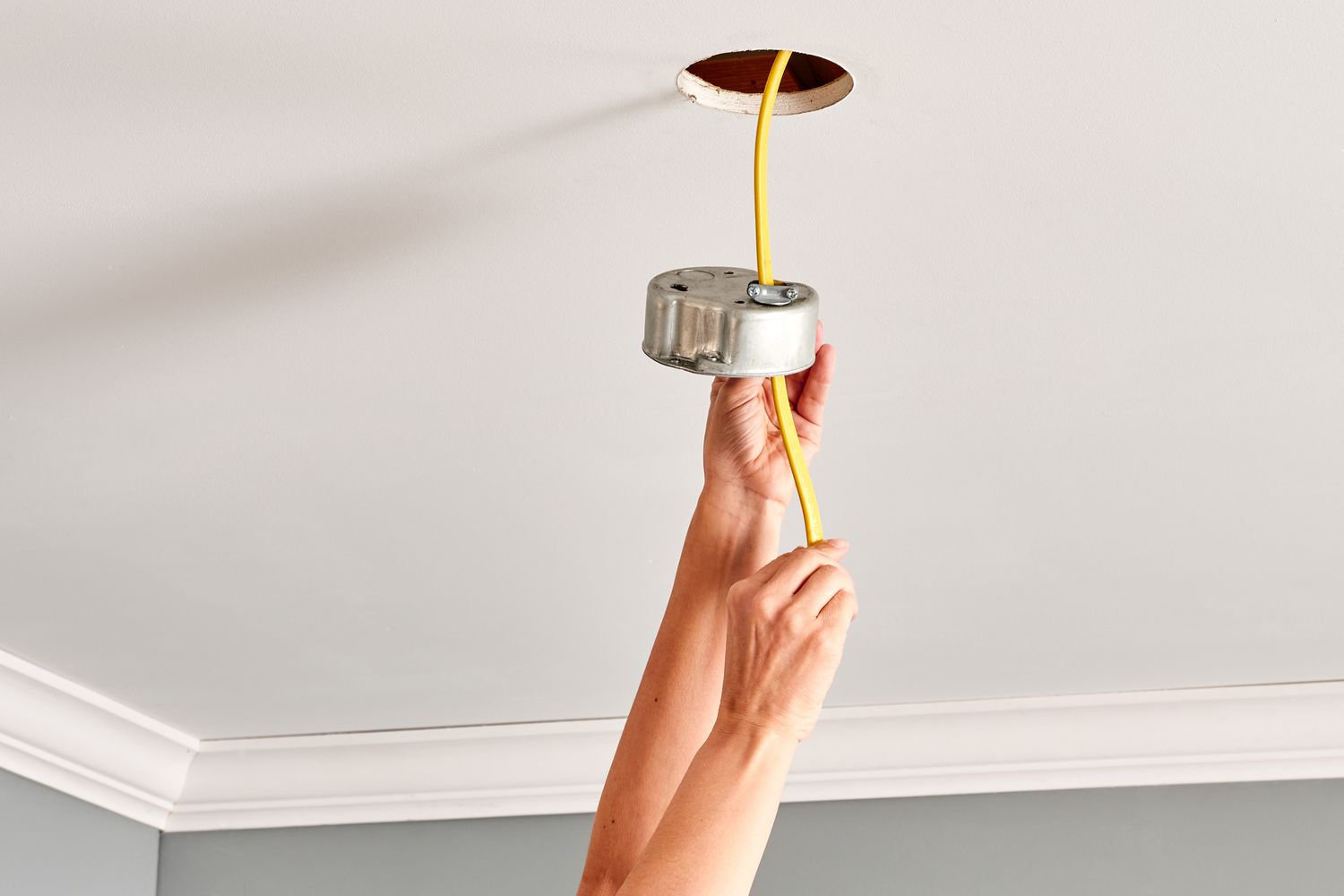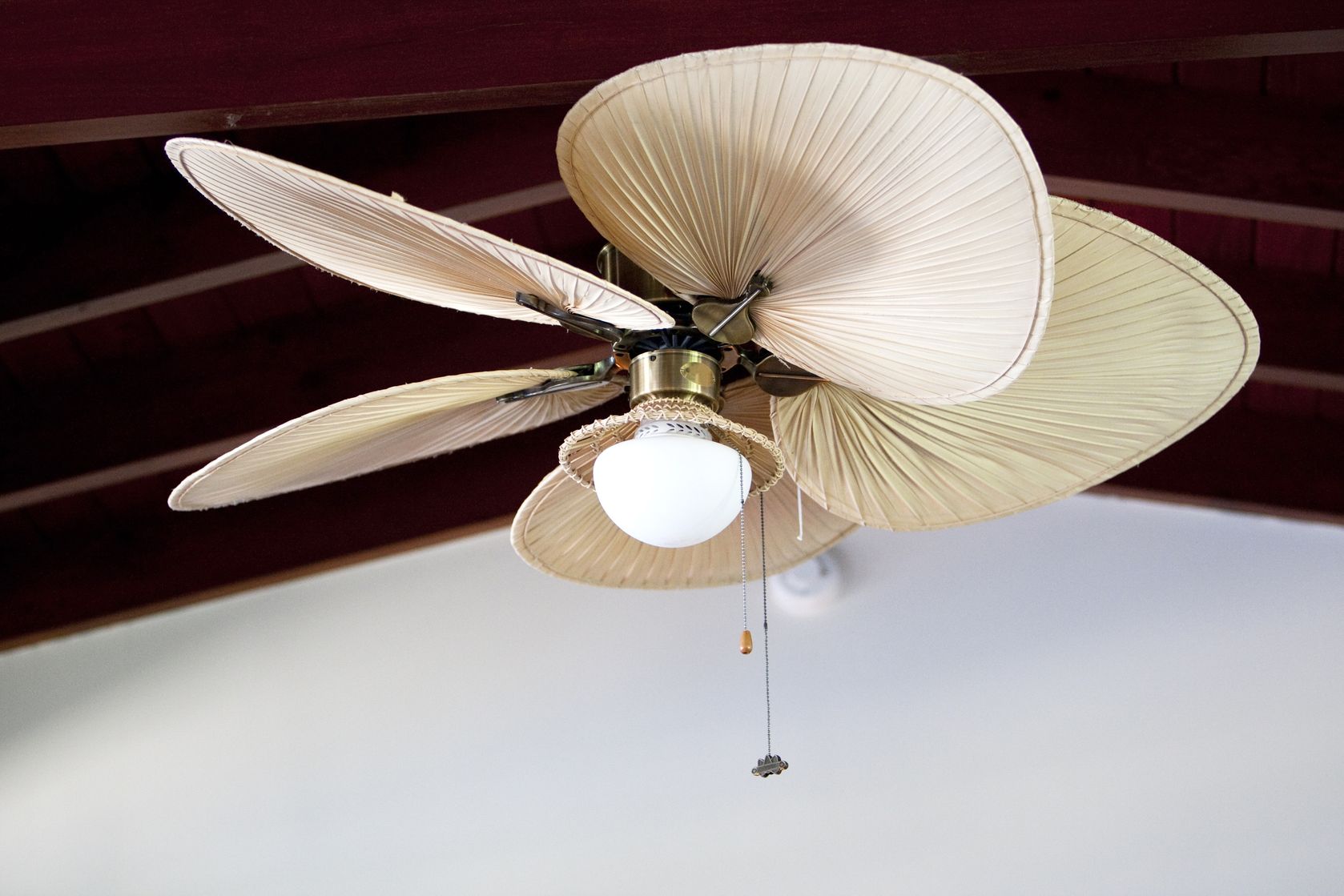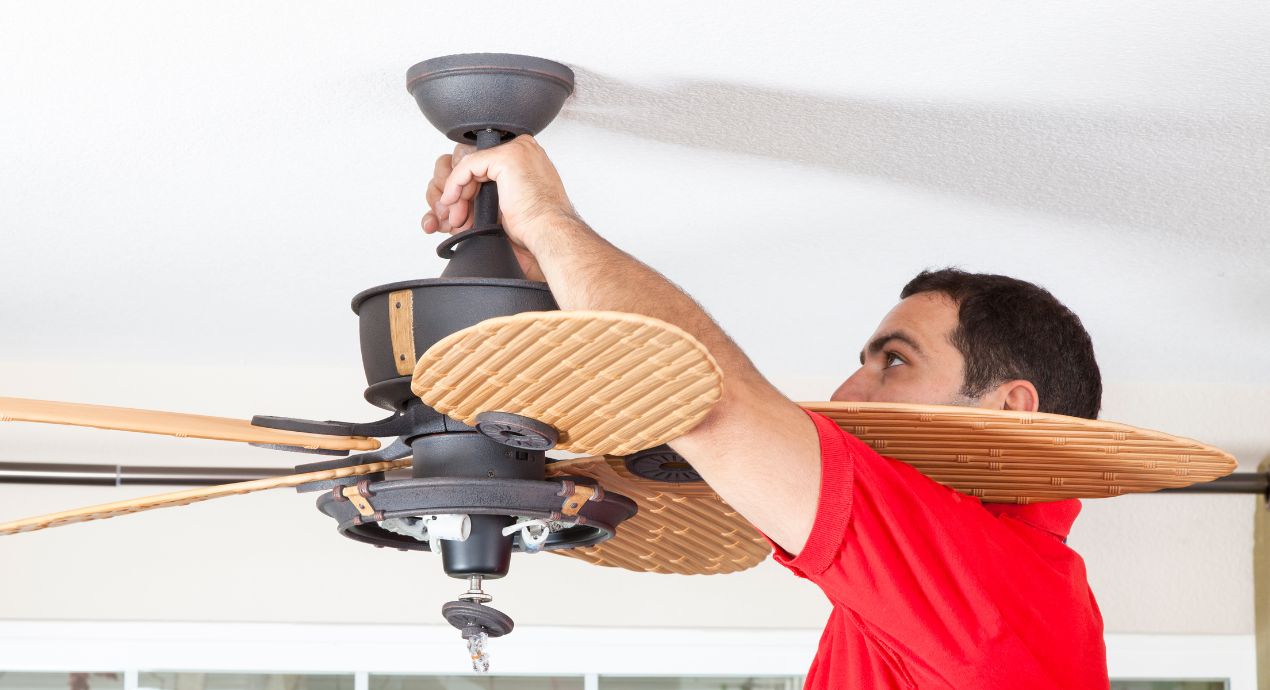

Articles
How Do You Measure A Ceiling Fan Size
Modified: September 2, 2024
Learn how to measure the size of a ceiling fan in this informative article. Discover the key factors to consider when choosing the right fan for your space.
(Many of the links in this article redirect to a specific reviewed product. Your purchase of these products through affiliate links helps to generate commission for Storables.com, at no extra cost. Learn more)
Introduction
A ceiling fan can be a stylish and functional addition to any space, providing comfort and helping to circulate air in a room. However, when it comes to choosing the right ceiling fan, size matters.
Measuring the size of a ceiling fan correctly is crucial to ensure optimal performance and efficiency. It helps determine whether the fan will provide sufficient air movement for the room and fit aesthetically within the space.
In this article, we will explore the various factors to consider when measuring the size of a ceiling fan. We will also provide a step-by-step guide to help you accurately determine the size of your ceiling fan. So, let’s dive in and discover how to measure a ceiling fan size!
Key Takeaways:
- Choosing the right ceiling fan size is crucial for optimal performance, energy efficiency, and aesthetic appeal. Consider room size, ceiling height, and clearance space to ensure the perfect fit for your space.
- Accurate measurements of blade span, fan size, and downrod length are essential for selecting the ideal ceiling fan. Avoid common mistakes and consult professionals for a well-sized, stylish, and functional addition to your home.
Read more: What Size Bulb for Ceiling Fan
Factors to Consider When Measuring Ceiling Fan Size
Measuring the size of a ceiling fan goes beyond simply looking at the circumference of the blades. There are several factors to consider that will help you determine the appropriate size for your space. Let’s explore these factors:
- Room Size: The size of the room plays a vital role in determining the size of the ceiling fan. Larger rooms require fans with larger blade spans to effectively circulate air. Smaller rooms, on the other hand, can be adequately served by fans with smaller blade spans.
- Ceiling Height: The height of your ceiling is another important consideration. It is recommended to keep a minimum distance of 7 feet between the floor and the blades of the fan. If your ceiling is higher, you may need to use an downrod to maintain an ideal distance.
- Room Function: Consider the function of the room where the fan will be installed. For example, a larger fan with stronger airflow might be more suitable for a living room or bedroom, while a smaller fan may suffice for a smaller space like a study or kitchen.
- Style and Aesthetics: Choose a fan size that complements the overall style and decor of the room. A large, ornate fan may look out of place in a small, minimalist room, while a small fan might not be visually impactful in a large, grand space.
By taking these factors into account, you can ensure that you select a ceiling fan size that not only meets your comfort needs but also enhances the aesthetic appeal of your space.
Step-by-Step Guide to Measure Ceiling Fan Size
Measuring the size of a ceiling fan is a straightforward process that can be done with a few simple steps. Here’s a step-by-step guide to help you accurately measure the size of your ceiling fan:
- Determine the Blade Span: The blade span refers to the diameter of the circular path traced by the outer edge of the fan blades. Start by measuring the distance from the center of the fan to the tip of one blade. Double this measurement to get the blade span.
- Calculate the Blade Sweep: The blade sweep is another important measurement that determines the air movement capacity of the fan. To calculate the blade sweep, multiply the blade span by 2. For example, if the blade span is 24 inches, the blade sweep would be 48 inches.
- Measure the Downrod Length: If your ceiling fan has a downrod, you should also measure its length. The downrod is the connecting piece between the fan motor and the ceiling mount. Measure the length of the downrod from the top of the fan motor to the bottom of the fan housing.
- Consider the Distance to Walls: Take into account the clearance space required between the fan blades and the walls. To ensure optimal airflow, there should be a minimum distance of 24 inches between the blades and any obstruction.
- Note the Fan Height: Finally, measure the height of the ceiling fan from the ceiling mount to the bottom of the fan housing. This measurement is crucial, especially if you have a low ceiling, to ensure sufficient clearance for the fan.
By following these steps, you can accurately measure the size of your ceiling fan and gather all the necessary information needed when choosing the right fan for your space.
Understanding Blade Span and Fan Size
When measuring ceiling fan size, understanding the concepts of blade span and fan size is essential. Let’s take a closer look at these terms:
Blade Span: The blade span refers to the diameter of the circular path traced by the outer edge of the fan blades. It is typically measured in inches and directly affects the air movement capacity of the fan. A larger blade span means a larger area of air circulation.
Fan Size: Fan size, on the other hand, encompasses various aspects of the fan, including the blade span, overall dimensions, and motor power. It represents the overall physical size of the fan and is often categorized into different sizes, such as small, medium, or large, based on the blade span.
When choosing a ceiling fan, it’s important to consider both the blade span and fan size to ensure optimal performance and efficiency. A fan with a larger blade span will generally provide more air movement, making it suitable for larger rooms. Conversely, a smaller blade span is more suitable for smaller spaces where a gentler breeze is desired.
It’s worth noting that fan size is not solely dependent on blade span. Other factors, such as the motor power and the angle of the blades, also contribute to the overall performance of the fan. So, when considering the size of a ceiling fan, it’s important to take into account all these elements to make an informed decision.
By understanding blade span and fan size, you can choose a ceiling fan that is not only aesthetically pleasing but also provides the right amount of airflow for your specific space.
When measuring a ceiling fan, start by determining the blade span (the diameter of the circle made by the rotating blades) to get an accurate size. This is typically measured in inches from the tip of one blade to the tip of the opposite blade.
Importance of Measuring Ceiling Fan Size Correctly
Accurately measuring the size of a ceiling fan is of utmost importance when it comes to ensuring its performance, efficiency, and overall functionality. Here are some reasons highlighting the importance of measuring ceiling fan size correctly:
- Air Circulation: The primary function of a ceiling fan is to circulate air in the room. Choosing the right size ensures that the fan has the appropriate blade span to generate sufficient airflow. A fan that is too small for the room may not provide adequate circulation, while a larger fan may create an uncomfortable breeze.
- Comfort and Energy Efficiency: A properly sized ceiling fan can provide optimal comfort by effectively cooling a room. When the fan is the right size, it can operate efficiently, reducing the need for air conditioning and lowering energy consumption. This can lead to lower utility bills and a more sustainable living environment.
- Aesthetic Appeal: Measuring the ceiling fan size correctly helps ensure that it fits harmoniously within the room’s layout and design. A fan that is too large or too small can disrupt the overall aesthetic balance and become an eyesore. On the other hand, a properly sized fan can enhance the visual appeal and complement the décor.
- Safety: Properly measuring the size of a ceiling fan also takes into account the clearance space needed between the blades and any obstructions, such as walls or furniture. This ensures safe operation and prevents accidents or damage to the fan or surrounding objects.
By measuring the ceiling fan size correctly, you can optimize its performance, enhance energy efficiency, improve comfort levels, and maintain the overall visual harmony of the room. It also promotes a safe environment, ensuring that the fan operates without any hazards or complications.
Considering these factors, it is evident that measuring ceiling fan size correctly is crucial for a functional and aesthetically pleasing addition to your space.
Read more: What Size Ceiling Fan For Bedroom
Common Mistakes to Avoid When Measuring Ceiling Fan Size
Measuring the size of a ceiling fan accurately is essential to ensure optimal performance and a seamless installation. However, there are some common mistakes that you should avoid when measuring the ceiling fan size. Let’s take a look at these mistakes:
- Not Considering Room Size: One of the biggest mistakes is not taking the room size into account when measuring the fan size. A fan that is too small for a large room may not provide sufficient air circulation, while a fan that is too large for a small room can overpower the space.
- Ignoring Ceiling Height: Another mistake is neglecting to consider the ceiling height. It’s important to ensure that the fan has enough clearance from the ceiling to avoid any obstructions and to maximize its airflow.
- Disregarding Aesthetic Appeal: Focusing solely on the technical aspects and disregarding the aesthetic appeal is a common mistake. The right ceiling fan size not only provides comfort but also enhances the overall visual appeal of the room.
- Forgetting about Clearance Space: When measuring the ceiling fan size, many people forget to account for the clearance space required between the fan blades and any nearby walls or furniture. This can lead to improper airflow and potential damage to both the fan and surrounding objects.
- Not Consulting a Professional: DIY measurements can be prone to errors, especially if you are not familiar with the process. It’s always a good idea to consult a professional or refer to manufacturer guidelines for accurate measurements.
By avoiding these common mistakes, you can ensure that you measure the ceiling fan size correctly, choose the right fan for your space, and enjoy optimal performance, comfort, and aesthetic appeal.
Remember, precise measurements and careful consideration of factors like room size, ceiling height, clearance space, and aesthetic appeal are key to selecting the perfect ceiling fan size for your needs.
Conclusion
Choosing the right size for your ceiling fan is crucial for its performance, energy efficiency, and overall aesthetic appeal. By carefully measuring the size of the fan, considering factors like room size, ceiling height, and clearance space, you can ensure that the fan provides optimal airflow and enhances the comfort of your space.
Accurate measurements of the blade span, fan size, and downrod length allow you to select a ceiling fan that suits your specific needs and complements the style of your room. It’s important to avoid common mistakes such as overlooking room size, ignoring ceiling height, forgetting clearance space, and neglecting the aesthetic appeal.
Remember, a properly sized ceiling fan not only improves air circulation and comfort but also contributes to energy efficiency by reducing the reliance on air conditioning. It can also enhance the visual harmony of the room, creating a more pleasant and inviting environment.
Whether you’re choosing a ceiling fan for your living room, bedroom, or any other space, make sure to measure the size correctly and consult professionals or manufacturer guidelines if needed. With the right size and design, your ceiling fan will not only keep you cool but also be a stylish addition to your home.
So, take the time to measure your ceiling fan size accurately and choose the perfect fan for your space. Enjoy the benefits of a well-sized and properly installed ceiling fan for years to come!
Now that you've mastered measuring ceiling fan sizes, why stop there? Ready to tackle ceiling fan installation yourself? Our guide on how to install a ceiling fan where a light was will walk you through every step, ensuring you can handle this upgrade with confidence. And if you're itching for more DIY home projects, we've got plenty of ideas to keep you busy. From simple fixes to more ambitious endeavors, you'll find all the resources needed to transform your space with your own two hands.
Frequently Asked Questions about How Do You Measure A Ceiling Fan Size
Was this page helpful?
At Storables.com, we guarantee accurate and reliable information. Our content, validated by Expert Board Contributors, is crafted following stringent Editorial Policies. We're committed to providing you with well-researched, expert-backed insights for all your informational needs.















0 thoughts on “How Do You Measure A Ceiling Fan Size”